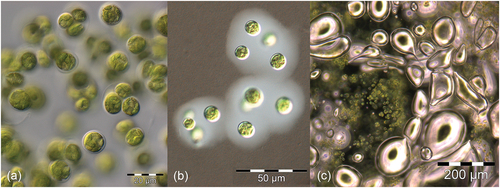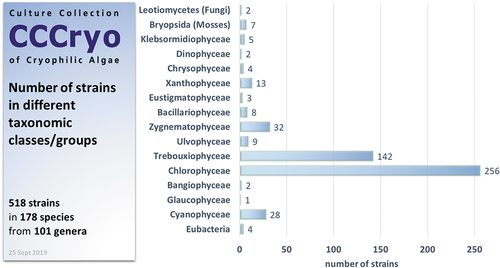Figures & data
Figure 1. Stock cultures of CCCryo strains from cold locations are maintained in commercial fridges with glass doors for external irradiance at a temperature of 1–5°C. At the top right a small heated box for thermophilic cyanobacteria and red algae cultured at 35°C is visible, next to it are agar slants and culture flasks for isolates that prefer room temperature for growth.
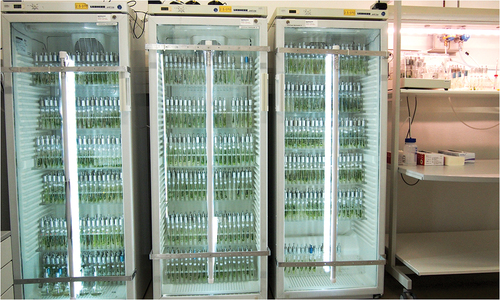
Table 1. List of all species cultured at CCCryo and their classification according to their temperature demands (temp.): pp = psychrophilic, pt = psychrotolerant, me = mesophilic, th = thermophilic, n.d. = not determined. For completeness of typical snow and glacier taxa the species of Chlamydomonas nivalis, Sanguina aurantia, S. nivaloides, Ancylonema nordenskiöldii and Mesotaenium berggrenii are listed as well. Of these taxa only field samples and/or cyst stages are stored at CCCryo as frozen archives, however, these cannot be ordered. The correct identity for some of the cryophilic taxa could not be determined finally and these carry “cf.” (= confer) in front of their genus name or species epithet and need to be studied in further, detailed phylogenetic analyses. Those unspecified listings carry a number or other code after the “sp.” and could only be described to genus level so far, however, different morphospecies had been identified and this is reflected by their unique species suffix. Classification according to Guiry (Citation2018).
Figure 3. Key data reflecting the quality of the CCCryo strains: axenic = free from bacteria and fungi; clonal = strain originated from a single cell, i.e. the strain is genetically clonal; colony pick = strain originated from a colony, i.e. presumably the strain is genetically clonal; non-alive = these listings comprise unculturable cysts or field material; however they are listed in the database to provide this rare information to the scientific community; “cf.” genus/species = strains with so far unclear identity on genus or species level; authentic strains = these strains represent type strains that are deposited at other collections, herbaria or museums in a metabolically inactive state.
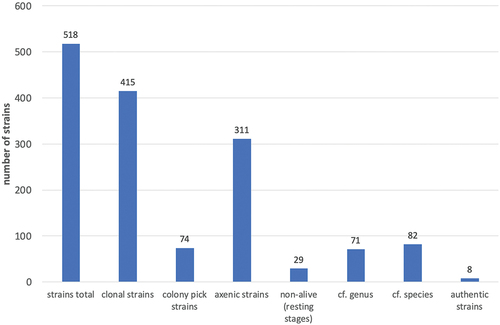
Figure 4. Number of CCCryo strains and their geographic origin. [earth-international = these 14 strains refer to isolates of a green alga (CCCryo 101–99) and Nostoc punctiforme from Spitsbergen (Svalbard) and Antarctica respectively that spent 469 days on the outside of the International Space Station ISS. To mark their stay outside of the Earth, they were labelled “origin: Earth-international” (J-P et al., Citation2019)].
![Figure 4. Number of CCCryo strains and their geographic origin. [earth-international = these 14 strains refer to isolates of a green alga (CCCryo 101–99) and Nostoc punctiforme from Spitsbergen (Svalbard) and Antarctica respectively that spent 469 days on the outside of the International Space Station ISS. To mark their stay outside of the Earth, they were labelled “origin: Earth-international” (J-P et al., Citation2019)].](/cms/asset/51ca51f2-89c0-47c5-ba50-3645349953d1/tapy_a_1753572_f0004_oc.jpg)
Figure 5. Comparison of the psychrophilic Raphidonema nivale strain CCCryo 381–11 with the Vischeria sp. (formerly Chloridella simplex) strain SAG 51.91 regarding the production of the omega-3 fatty acid EPA (eicosapentaenoic acid) under different temperature and light conditions. (a) depicts EPA productivity taking the photon fluence rate E into account. (b) shows the productivity per litre and day. Cultures were bubbled with either sterile filtered air (closed symbols) or additional 3–5 v/v % CO2 (open symbols).
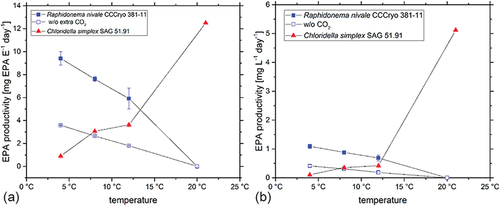
Figure 6. Fatty acid profile of strain CCCryo 198–04 of a Koliella sp. with long-chain fatty acids. (N+ = nitrate-containing medium, N- = nitrate-depleted medium); from Schulze, Citation2011).
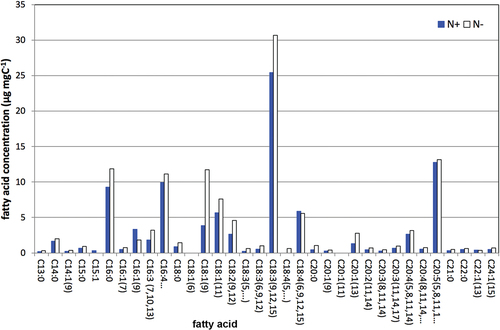
Figure 7. Carotenoid spectrum of a CCCryo strain from permafrost. (a) Carotenoids and chlorophylls as concentrations of dry mass. (b) Single carotenes and xanthophylls as ratios of all carotenoids detectable present. (data from the Fraunhofer-internal project MassCaro, unpublished).
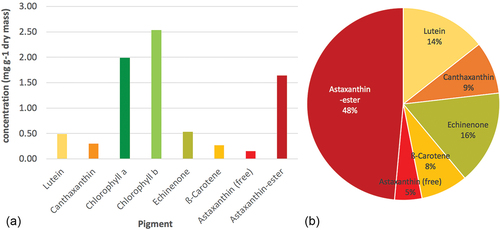
Figure 8. Extracellular polymeric substances (EPS) produced by strain CCCryo 147–01 of Gloeocystis sp., a psychrophilic isolate from snow. (a) Single cells and four-celled sporangia surrounded by EPS. (b) The mucilage layer made visible by negative staining with Burri’s ink. (c) When centrifuged some green cells remain trapped within a gel-like, form stable mass capable of trapping air bubbles.
